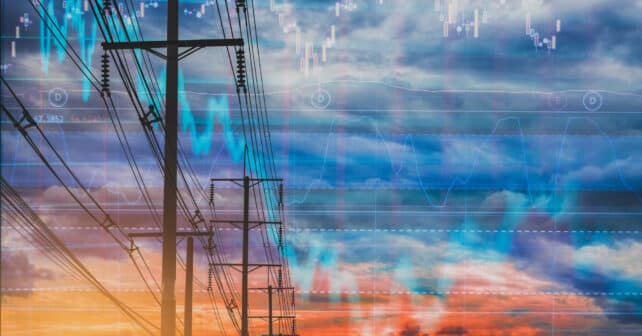
Energy derivatives play an important role in aiding energy providers to hedge their risks amid the recent volatility in European energy markets. Bob Currie looks at the evolution of energy derivatives in helping market participants to seek certainty in a time of price volatility.
Geopolitical instabilities have generated huge volatility in European energy markets over the past three years, forcing power utilities to review their hedging strategies and creating openings for trading desks seeking commercial opportunities to generate yield.
Following the Russian invasion of Ukraine, for example, the price of benchmark natural gas TTF futures climbed to 227 €/Mwh on 7 March 2022, according to European Central Bank data, before surging again to a historical high of 339 €/Mwh by late August, approximately 18 times its level in early 2021.
Against this background of high price volatility, supply constraints and relative inelastic demand from energy consumers, energy derivatives have performed an important role in helping energy providers to hedge their risk and to protect continuity of supply to households and corporates.
EEX CEO Peter Reitz, the European energy exchange majority-owned by Deutsche Borse Group, says that the ongoing geopolitical context, particularly the Russia-Ukraine conflict, has had a profound impact on energy markets. “The conflict has caused disruptions to energy supplies, particularly natural gas, which has historically been a significant component of the European energy mix,” says Reitz. “The reduction in Russian gas exports to Europe has led to increased volatility in energy prices, prompting market participants to seek more robust risk management solutions.”

These challenges have fed through into a marked increase in the trading volumes of energy derivatives, notably power and gas. “Market participants are actively using these instruments to hedge against price fluctuations and to secure their energy needs,” says Reitz.
Moreover, the shift towards renewable energy sources has influenced market behaviour. “As Europe aims to reduce its reliance on fossil fuels, there is a growing interest in green energy products and long-term contracts that support the transition to a more sustainable energy system,” he says.
For Wouter de Klein, Senior Director, Utility Markets at ICE, the energy crisis in 2022 caused massive supply disruption of natural gas, leading to tighter markets and a requirement to manage more energy security risk. “ICE, as the largest energy exchange globally, is key to price determination for natural gas, coal and oil, and the price of electricity is derived from the interaction of these competing input fuels,” he says.
“The more exposed international power markets are to international gas, the more that TTF natural gas contracts – as the anchor contract for global natural gas markets – is a primary price driver for EU and UK power,” says de Klein. Given this fuel linkage, ICE has continued to see increased activity on a structural level, with customers recognising the capital efficiencies and margin offsets they get by trading all of their energy products on one platform.
“The increase in European power trading activity is driven not only by increased screen quoting and trading of outright futures contracts, but also by a structural increase in activity in locational spreads [reflecting price variation across locations] and in OTC cleared blocks.” de Klein
“The increase in European power trading activity is driven not only by increased screen quoting and trading of outright futures contracts, but also by a structural increase in activity in locational spreads [reflecting price variation across locations] and in OTC cleared blocks,” says de Klein.
Saeed Noury, CEO and founder of brokerage, clearing and risk management house Novion, has observed a significant increase in trading volumes among participants in the physical commodities markets. Prior to 2022, he notes that many operated without hedging their price exposures. However, recent geopolitical events have heightened market volatility, underscoring the risks associated with unhedged positions.
Throughout 2024, Novion expanded its power and energy derivatives portfolio, introducing new products in both over-the-counter (OTC) and futures markets to meet client demand. During 2025, the company plans to introduce structured options to further extend its product offer. “These initiatives align with our strategic objectives to broaden our global reach and to support the integration of renewable energy sources, tailoring solutions to clients’ needs,” he says.
Spark Spread Complex
The price signals offered by energy derivatives exchanges played an important role during this period of high volatility in helping to balance supply and demand while identifying, and helping to resolve, infrastructure bottlenecks. This price information was also used to guide investment decisions as high prices underscored the requirement for new LNG supply. “For example, the US became the top LNG supplier to the EU and Germany constructed its first LNG import terminal just months after Russia reduced pipeline flows,” says ICE’s de Klein.

Reitz indicates that EEX has seen trading volumes rise substantially in its power derivatives markets, including Europe and Japan. However the circumstances are rather different across these locations. Since launching power futures in Japan in 2020, EEX has worked closely with the local and international trading communities, and with the market authorities, to establish the market and to build growth in this sector. This is reflected in a four-fold increase in EEX’s annual trading volume in Japanese power futures for 2024 relative to 2023.
“In Europe, EEX is marking its twenty-fifth anniversary and we attribute growth to working closely with clients to establish new contracts to meet their requirements, alongside the general surge in volatility in energy and power markets,” says Reitz.
At ICE, de Klein observes that growth in trading participation is coming from North America and Asia, as well as from Europe. This is driven particularly by trading desks at financial institutions looking for yield opportunities in trading power contracts – which is an important source of liquidity through ICE.
Focusing on Europe, January 2025 was a record month for EU power futures on ICE, with volumes up 74% month-on-month following a record December. This also built on a record 2024 for EU power futures and options combined, with more than 800,000 contracts traded over the 12 months representing a 169% increase year-on-year.
In German power, liquidity has deepened dramatically over the past 12 to 18 months. Key to this is that customers are looking to trade at the ‘best price’, says de Klein, providing confidence to the trader that the market is sufficiently liquid that they can enter or exit their positions at any point during the trading day. “These fundamentals have been important in ensuring that traders can respond to pricing uncertainties in the market with certainty through their trading and risk management strategies.”
For German power derivatives, ICE has built market depth to complement the strong liquidity already offered in natural gas andcarbon contracts. Many trading firms find it commercially attractive to trade the Spark Spread complex – a measure of the difference between the spot price of electricity and the cost of producing electricity using natural gas, taking into account the cost of offsetting CO2 emissions when generating the power through that mechanism.
“There were a lot of firms already active on ICE in other contracts, such as Brent Crude futures and options, TTF natural gas and in the EUA carbon allowance benchmark contract,” says de Klein. “In doing so, we are enabling customers to trade the Spark Spread complex on a single platform, offering cross-margining benefits across the three types of contracts as well as strong liquidity in each of these instruments, which is really attractive to traders.”
Infrastructure consolidation
In the Nordic and Baltic region, there is already evidence of structural reorganisation in the infrastructure space, with Euronext confirming a binding agreement on 28 Jan to purchase Nasdaq Nordic’s power derivatives business. The two parties plan to migrate Nasdaq Nordic power futures business to Euronext during H1 2026, subject to regulatory approval, with trading operating from Euronext Amsterdam and being cleared through Euronext Clearing.
Commenting on the transaction, Camille Beudin, Euronext Head of Diversified Services, said: “The acquisition of Nasdaq’s Nordic power futures is a major accelerator for our power futures ambitions and positions Euronext as a leading player for trading and hedging of power in Europe, [building on] on an efficient and integrating trading and clearing setup to deliver a long-standing and liquid power futures market for the Nordic and Baltic region.”
This proposed acquisition follows an announcement from Euronext and power exchange operator Nord Pool in August 2024 that they plan to launch a Nordic and Baltic power futures market. Client testing for the Euronext Nord Pool power futures offering will open in March 2025, with the infrastructure created as part of this project expected to go live in June 2025.
The Road to Net-Zero?
Future strategy in energy markets will be shaped by the choices made by producers, consumers and policymakers in managing the conversion to renewable energy sources. But what role will energy derivatives play in this transition to net-zero?
Reitz indicates that EEX’s markets play an important role in promoting energy security and facilitating the transition to net zero by providing market participants with the tools to manage price risks and secure energy supplies.
For instance, EEX recently launched Nordic Zonal Futures to provide precise hedging tools for market participants in the Nordic region, which is heavily reliant on renewable energy. “These products help to stabilise revenues for renewable energy producers and encourage further investment in green technologies,” he says.
In spot markets, the exchange offers intraday trading of power derivatives in 15-minute blocks, which can be traded up to five minutes before delivery. This allows market participants to make last-minute adjustments and to balance their positions. Trading is also available through intraday auctions.
Additionally, EEX is a provider of registry services for Guarantees of Origin (GO) in France and supports a range of GO products, including the launch of GO Futures in September. These GO futures contracts are the “first of their kind”, notes Reitz, and have attracted strong interest in their first four months of trading.
ICE’s de Klein takes the view that futures markets can certainly help to deliver net zero. This will require significant capital reallocation and price transparency will be critical to risk transfer and to allocating capital efficiently.
Expanding on this point, de Klein notes that two things are essential to change the way that energy is produced and consumed – namely the price of energy and the price of carbon. It will be principally economic factors, he believes, that will drive companies and consumers to change their behaviour – and price determination is fundamental for economics to work effectively.
“Futures exchanges meet our need for this pricing information,” he concludes. ”ICE has a 20-year track record in delivering the price of energy and the price of carbon through which firms can manage climate risk.”
